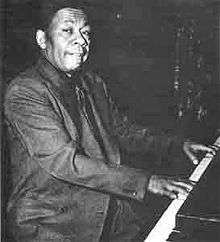Cripple Clarence Lofton
| Cripple Clarence Lofton | |
|---|---|
 | |
| Background information | |
| Birth name | Albert or Clarence Clemens |
| Born |
March 28, 1887 or 1897 Kingsport or Burns, Tennessee, United States |
| Died |
January 9, 1957 (age 59-69) Chicago, Illinois, United States[1] |
| Genres | Blues, boogie-woogie, twelve-bar blues |
| Occupation(s) | Musician, songwriter, tap dancer |
| Instruments | Vocals, piano |
| Labels | Vocalion Records,[2] Document Records |
| Associated acts | Big Bill Broonzy |
Clarence Lofton (March 28, 1887,[1] 1896 or 1897 – January 9, 1957),[3] credited as Cripple Clarence Lofton, was an American boogie-woogie pianist and singer born in Tennessee.
Life and career
There is uncertainty over his birth details. Many sources state that he was born Albert Clemens in 1887, in Kingsport, Tennessee.[1] However, researchers Bob Eagle and Eric LeBlanc state that, based on information in official records, he was born Clarence Clemens in 1896 or 1897, in Burns, Tennessee, and may have been adopted as Clarence Ramsey. They also consider that Albert (or Elbert) Clemens, born c.1903, who was also a singer and pianist who recorded for Bluebird Records, was his brother.[3]
Though Lofton was born with a limp, from which he derived his stage name, he actually started his career as a tap-dancer.[1] Lofton moved on from tap-dancing into the blues idiom known as boogie-woogie and moved on to perform in Chicago, Illinois. The trademark of Lofton's performances was his energetic stage-presence, where he danced and whistled in addition to singing.[2] A conversant description of Lofton is provided in an excerpt from Boogie Woogie by William Russell:
No one can complain of Clarence's lack of variety or versatility. When he really gets going he's a three-ring circus. During one number, he plays, sings, whistles a chorus, and snaps his fingers with the technique of a Spanish dancer to give further percussive accompaniment to his blues. At times he turns sideways, almost with his back to the piano as he keeps pounding away at the keyboard and stomping his feet, meanwhile continuing to sing and shout at his audience or his drummer. Suddenly in the middle of a number he jumps up, his hands clasped in front of him, and walks around the piano stool, and then, unexpectedly, out booms a vocal break in a bass voice from somewhere. One second later, he has turned and is back at the keyboard, both hands flying at lightning-like pace. His actions and facial expressions are as intensely dramatic and exciting as his music."[4]
With his distinctive performance style, Lofton found himself a mainstay in his genre: His first recording was in April 1935 for Vocalion Records with guitar accompaniment from Big Bill Broonzy.[5] He also accompanied Red Nelson on several sides for Decca Records during 1935 and 1936.[6] He later went on to own the Big Apple nightclub in Chicago and continued to record well into the late 1940s, when he retired.[1]
Lofton lived in Chicago until he died from a blood clot in his brain in Cook County Hospital in 1957.[3][1]
Influence
Lofton was an integral part of the boogie-woogie genre in Chicago.[4] Some of his more popular songs include: "Strut That Thing", "Monkey Man Blues", "I Don't Know" and "Pitchin' Boogie". His talent was likened to that of Pinetop Smith and other prominent boogie-woogie artists including: Meade Lux Lewis, Cow Cow Davenport and Jimmy Yancey. Lofton was also said to have influenced Erwin Helfer.[7]
Discography
- 1979 - Clarence's Blues, Oldie Blues, OL 2817
References
- 1 2 3 4 5 6 Cub Koda. "Cripple Clarence Lofton - Biography - AllMusic". AllMusic. Retrieved 19 January 2015.
- 1 2 "Cripple Clarence Lofton Vol 2 1939 - 1943". Document-records.com. Retrieved 19 January 2015.
- 1 2 3 Eagle, Bob; LeBlanc, Eric S. (2013). Blues - A Regional Experience. Santa Barbara: Praeger Publishers. p. 150. ISBN 978-0313344237.
- 1 2 "Boogie Woogie by William Russell". Colindavey.com. Retrieved 19 January 2015.
- ↑ Olderen, Martin van, Clarence's Blues, liner notes Oldie Blues OL 2817, 1979
- ↑ "Red Nelson | Biography & History". AllMusic. 1907-08-31. Retrieved 2016-11-02.
- ↑ Archived July 10, 2011, at the Wayback Machine.